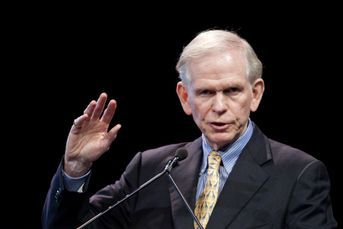Fund companies, traders under new scrutiny with Volcker rule
SEC, other regulators, pass rule after three years of back and forth with Wall Street.
Wall Street faces more intensive government scrutiny of trading after U.S. regulators issued what they billed as a strict Volcker rule Tuesday, imposing new curbs designed to prevent financial blowups while leaving many details to be worked out later.
The Federal Reserve and Federal Deposit Insurance Corp. voted unanimously to adopt the proprietary trading ban and three other agencies were to complete their approvals by the end of the day. The rule has been contested by JPMorgan Chase & Co., the Goldman Sachs Group Inc. and their industry allies for more than three years.
Wall Street’s lobbying efforts paid off in easing some provisions of the rule. Regulators granted a broader exemption for banks’ market-making desks, on the condition that traders aren’t paid in a way that rewards proprietary trading. The regulation also exempts some securities tied to foreign sovereign debt.
At the same time, regulators said the final version imposed stricter restrictions on hedging, providing banks less leeway for classifying bets as broad hedges for other risks. To pursue a hedge, banks would need to provide detailed and updated information for review by on-site bank supervisors.
LIMITING RISKS
“This provision of the Dodd-Frank Act has the important objective of limiting excessive risk-taking by depository institutions and their affiliates,” Fed Chairman Ben S. Bernanke said in a statement. “The ultimate effectiveness of the rule will depend importantly on supervisors, who will need to find the appropriate balance while providing feedback to the board on how the rule works in practice.”
The Fed gave banks a delay until July 21, 2015, to comply with the rule. Beginning June 30, 2014, banks with $50 billion in consolidated assets and liabilities must report quantitative information about their trading.
The rule is named for Paul Volcker, the former Fed chairman credited with taming rampant inflation in the 1970s and who served as a top adviser to President Barack Obama. Mr. Volcker, 86, proposed the ban as a means of restoring stability to Wall Street following the 2008 financial crisis, arguing that banks that benefit from federal deposit insurance and discount borrowing shouldn’t be permitted to take risks that could trigger a taxpayer-funded government bailout.
The rule, enshrined by the Dodd-Frank Act of 2010, allows exemptions for market-making and some hedging, and defines limits for banks’ investments in private-equity and hedge funds. The version issued Tuesday is 71 pages long, with an additional 850-page preamble.
“This rule is so complex and massive that it is essential that the regulators not conflate inadvertent mistakes with purposeful violations,” H. Rodgin Cohen, senior chairman of the Sullivan & Cromwell law firm, which represents Wall Street banks, wrote in an e-mailed statement.
With Wall Street banks already having shut proprietary trading desks in anticipation of the rule, its remaining impact rests largely on the fine print and on how regulators conduct oversight of other banking activities, primarily market making and hedging.
Wall Street’s five largest firms had as much as $44 billion in revenue at stake on the outcome of just the market-making provision, according to data for the year ended Sept. 30. JPMorgan, the biggest U.S. lender by assets, had as much as $11.4 billion riding on the answer.
SETS PARAMETERS
The rule by the Fed, FDIC, Securities and Exchange Commission, Commodity Futures Trading Commission and Office of the Comptroller of the Currency sets parameters for how banks may buy and sell financial products for clients and manage their own risks in the process.
Business groups, which have sued to overturn several Dodd-Frank rules based on the quality of regulators’ economic analysis, have signaled that they may challenge the Volcker rule in court.
“We will now have to carefully examine the final rule to consider the impact on liquidity and market making, and take all options into account as we decide how best to proceed,” David Hirschmann, president of the U.S. Chamber of Commerce’s Center for Capital Markets Competitiveness, said in a statement.
The SEC, which typically provides an economic analysis for each of its rules, didn’t conduct a separate cost-benefit analysis for Volcker because regulators said they wrote the rule under a banking law that doesn’t require it.
“Comments on the potential economic effects of the Volcker rule were particularly important in shaping revisions that have produced a more tailored and more effective final rule,” SEC Chairman Mary Jo White said in a statement. “These comments addressed unintended consequences and offered alternatives for consideration, and these views were taken into account.”
The final version got a positive review from lawmakers who championed it. Sen. Carl Levin, D-Mich., and Sen. Jeff Merkley, D-Ore., said the final rule “looks improved” from the 2011 proposal.
“We are still reviewing the details of the final rule, but early indications suggest that persistence and common sense can prevail in the face of even the fiercest special interest lobbying campaigns: Hedging looks tougher, market making looks simpler, trader compensation remains appropriately structured, and CEOs are required to set the tone at the top,” the senators said in a joint statement.
Here are summaries of the rule’s major provisions:
Making markets
The Volcker rule bans banks from trading to profit for their own accounts while allowing them to continue making markets for clients. Distinguishing between those two practices has been one of the most difficult tasks for regulators.
In the final rule, regulators eased the criteria banks must meet to qualify for the market-making exemption. To receive the exemption, a trading desk must both buy and sell contracts or enter into both long and short positions of those instruments for its own account.
The trades must not exceed, on an ongoing basis, the “reasonably expected near-term demands of clients.” The rule instructs banks to determine that demand based on historical data and other market factors. Further, the rule requires that compensation arrangements not be designed to reward prohibited trading.
Industry lobbyists had pressed for the exemption to be widened, saying banks need to build up inventories of stocks, bonds and other products to help clients when they eventually place orders. Banks were joined by asset managers such as the Vanguard Group Inc. and AllianceBernstein Holding LP in warning that a narrow exemption could unsettle markets.
Portfolio hedging
Regulators will require banks to demonstrate on an ongoing basis that their trades hedge specific risks in order to win an exemption from the Volcker rule ban.
The banks must analyze and independently test that a hedge “demonstrably reduces or otherwise significantly mitigates one or more specific, identifiable risks,” the rule said. Banks must provide “ongoing recalibration of the hedging activity by the banking entity” to ensure it is allowed.
The hedging provision became central to the Volcker rule debate after JPMorgan lost $6.2 billion last year in bets on credit derivatives known as the London Whale. The trades, conducted in the U.K. by the bank’s chief investment office and nicknamed for their market impact, were described by JPMorgan executives as a portfolio hedge.
Three months after the losses were disclosed in 2012, JPMorgan Chairman and Chief Executive Officer Jamie Dimon, told lawmakers that the Volcker ban “may very well have stopped parts of what this portfolio morphed into.”
Bart Chilton, a Democratic CFTC commissioner who earlier said he planned to vote against the rule because it was too weak, said it had been strengthened enough to win his support.
“The language has been solidified tightly to avoid loopholes,” Mr. Chilton said in a statement. “When people say this version of the Volcker rule will stop circumstances like the London Whale, this ongoing recalibration provision is exactly what will help avoid similar debacles.”
Sovereign debt
The buying and selling of securities backed by a foreign sovereign will not fall under the proprietary trading ban in most circumstances. That exemption includes securities issued by foreign central banks and applies to U.S. banks with overseas operations as well as foreign firms with affiliates in the U.S.
The initial Volcker rule draft drew international criticism for its reach into banks based overseas as well as for its impact on foreign sovereign-debt markets.
Michel Barnier, the European Union’s financial services chief, complained about the rule’s “extraterritorial consequences.” Canadian and Mexican bankers and government officials said the proprietary trading ban would violate the North American Free Trade Agreement’s guarantee that banks be allowed to deal equally in U.S. and Canadian debt obligations.
Regulators also allowed more flexibility for overseas banks. They will be exempt from the ban for trades accounted for outside the U.S. so long as their employees deciding to buy and sell contracts are also located outside the country. The final rule also frees overseas banks from the ban for trades they conduct on U.S.-based exchanges and clearinghouses, and for trades they have with foreign operations of U.S. banks.
Fund investments
The proprietary trading rule seeks to limit banks’ speculative bets in another way: by curbing their investments in private equity, hedge funds and commodity pools.
U.S. banks have already begun cutting their stakes in such funds, and will need to reduce them further to meet the law’s limit of 3% of Tier 1 capital invested in the funds. For example, Goldman Sachs cut its investment in such funds to $14.9 billion as of Sept. 30, down from $15.4 billion when Dodd-Frank was passed.
Regulators granted broader exemptions for some types of funds. Under the final rule, joint ventures, issuers of asset-backed securities and wholly-owned subsidiaries are among exempt funds.
CEO responsibility
Apart from the specific limits on bank investments and trading practices, the Volcker rule includes efforts to change the culture of trading on Wall Street.
Toward that end, the rule tells banks’ boards and top managers that they “are responsible for setting and communicating an appropriate culture of compliance.”
The centerpiece of the governance changes is a requirement that CEOs “annually attest in writing” that the company has “procedures to establish, maintain, enforce, review, test and modify” the compliance program.
The wording will be a relief to Wall Street chiefs who were concerned they would have to personally guarantee that their firms were in compliance with the rule, according to people familiar with the banks’ thinking. Executives already file a similar certification with the Financial Industry Regulatory Authority Inc., a self-regulatory group for brokerage firms.
Supervisory focus
In the end, after hundreds of pages outlining numerous what-if’s, exemptions and special circumstances, the rule reiterates that banks will now have to prove to supervisors that they are adhering to the overriding principle that Volcker and Obama put forward in 2010 as a way to prevent another financial meltdown.
According to documents released by the Fed, the rule prohibits “any transaction or activity” exposing banks to high-risk assets or strategies “that would substantially increase the likelihood that the banking entity would incur a substantial financial loss or would pose a threat to the financial stability of the United States.”
(Bloomberg News)
Learn more about reprints and licensing for this article.








